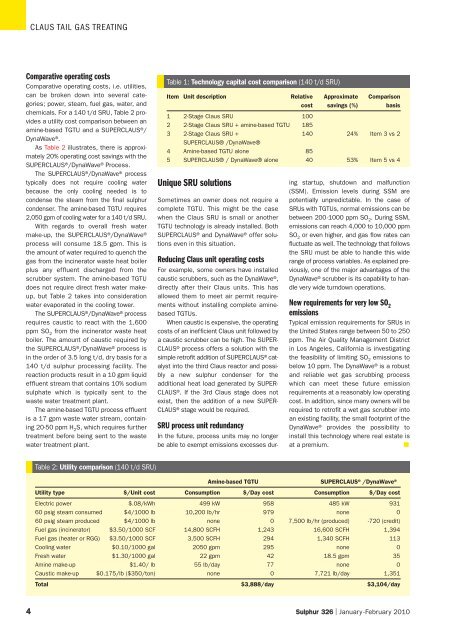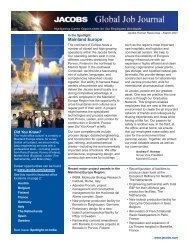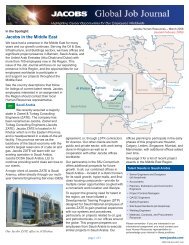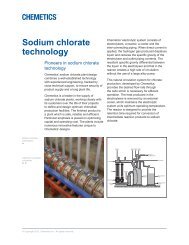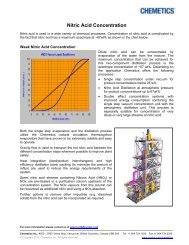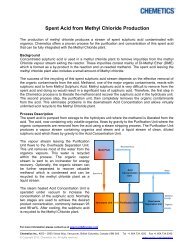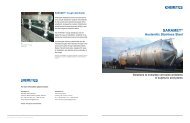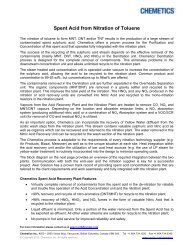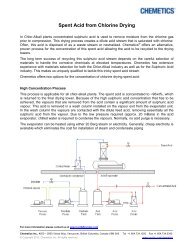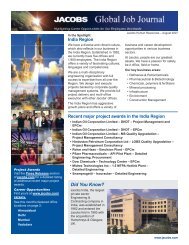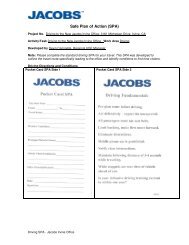SUPERCLAUS ®/ DynaWave ® process
SUPERCLAUS ®/ DynaWave ® process
SUPERCLAUS ®/ DynaWave ® process
Create successful ePaper yourself
Turn your PDF publications into a flip-book with our unique Google optimized e-Paper software.
CLAUS TAIL GAS TREATING<br />
Comparative operating costs<br />
Comparative operating costs, i.e. utilities,<br />
can be broken down into several categories;<br />
power, steam, fuel gas, water, and<br />
chemicals. For a 140 t/d SRU, Table 2 provides<br />
a utility cost comparison between an<br />
amine-based TGTU and a <strong>SUPERCLAUS</strong> <strong>®</strong> /<br />
<strong>DynaWave</strong> <strong>®</strong> .<br />
As Table 2 illustrates, there is approximately<br />
20% operating cost savings with the<br />
<strong>SUPERCLAUS</strong> <strong>®</strong> /<strong>DynaWave</strong> <strong>®</strong> Process.<br />
The <strong>SUPERCLAUS</strong> <strong>®</strong> /<strong>DynaWave</strong> <strong>®</strong> <strong>process</strong><br />
typically does not require cooling water<br />
because the only cooling needed is to<br />
condense the steam from the final sulphur<br />
condenser. The amine-based TGTU requires<br />
2,050 gpm of cooling water for a 140 t/d SRU.<br />
With regards to overall fresh water<br />
make-up, the <strong>SUPERCLAUS</strong> <strong>®</strong> /<strong>DynaWave</strong> <strong>®</strong><br />
<strong>process</strong> will consume 18.5 gpm. This is<br />
the amount of water required to quench the<br />
gas from the incinerator waste heat boiler<br />
plus any effluent discharged from the<br />
scrubber system. The amine-based TGTU<br />
does not require direct fresh water makeup,<br />
but Table 2 takes into consideration<br />
water evaporated in the cooling tower.<br />
The <strong>SUPERCLAUS</strong> <strong>®</strong> /<strong>DynaWave</strong> <strong>®</strong> <strong>process</strong><br />
requires caustic to react with the 1,600<br />
ppm SO 2 from the incinerator waste heat<br />
boiler. The amount of caustic required by<br />
the <strong>SUPERCLAUS</strong> <strong>®</strong> /<strong>DynaWave</strong> <strong>®</strong> <strong>process</strong> is<br />
in the order of 3.5 long t/d, dry basis for a<br />
140 t/d sulphur <strong>process</strong>ing facility. The<br />
reaction products result in a 10 gpm liquid<br />
effluent stream that contains 10% sodium<br />
sulphate which is typically sent to the<br />
waste water treatment plant.<br />
The amine-based TGTU <strong>process</strong> effluent<br />
is a 17 gpm waste water stream, containing<br />
20-50 ppm H 2 S, which requires further<br />
treatment before being sent to the waste<br />
water treatment plant.<br />
Table 2: Utility comparison (140 t/d SRU)<br />
Table 1: Technology capital cost comparison (140 t/d SRU)<br />
Item Unit description Relative Approximate Comparison<br />
cost savings (%) basis<br />
1 2-Stage Claus SRU 100<br />
2 2-Stage Claus SRU + amine-based TGTU 185<br />
3 2-Stage Claus SRU +<br />
<strong>SUPERCLAUS</strong><strong>®</strong> /<strong>DynaWave</strong><strong>®</strong><br />
140 24% Item 3 vs 2<br />
4 Amine-based TGTU alone 85<br />
5 <strong>SUPERCLAUS</strong><strong>®</strong> / <strong>DynaWave</strong><strong>®</strong> alone 40 53% Item 5 vs 4<br />
Unique SRU solutions<br />
Sometimes an owner does not require a<br />
complete TGTU. This might be the case<br />
when the Claus SRU is small or another<br />
TGTU technology is already installed. Both<br />
<strong>SUPERCLAUS</strong> <strong>®</strong> and <strong>DynaWave</strong> <strong>®</strong> offer solutions<br />
even in this situation.<br />
Reducing Claus unit operating costs<br />
For example, some owners have installed<br />
caustic scrubbers, such as the <strong>DynaWave</strong> <strong>®</strong> ,<br />
directly after their Claus units. This has<br />
allowed them to meet air permit requirements<br />
without installing complete aminebased<br />
TGTUs.<br />
When caustic is expensive, the operating<br />
costs of an inefficient Claus unit followed by<br />
a caustic scrubber can be high. The SUPER-<br />
CLAUS <strong>®</strong> <strong>process</strong> offers a solution with the<br />
simple retrofit addition of <strong>SUPERCLAUS</strong> <strong>®</strong> catalyst<br />
into the third Claus reactor and possibly<br />
a new sulphur condenser for the<br />
additional heat load generated by SUPER-<br />
CLAUS <strong>®</strong> . If the 3rd Claus stage does not<br />
exist, then the addition of a new SUPER-<br />
CLAUS <strong>®</strong> stage would be required.<br />
SRU <strong>process</strong> unit redundancy<br />
In the future, <strong>process</strong> units may no longer<br />
be able to exempt emissions excesses dur-<br />
ing startup, shutdown and malfunction<br />
(SSM). Emission levels during SSM are<br />
potentially unpredictable. In the case of<br />
SRUs with TGTUs, normal emissions can be<br />
between 200-1000 ppm SO 2 . During SSM,<br />
emissions can reach 4,000 to 10,000 ppm<br />
SO 2 or even higher, and gas flow rates can<br />
fluctuate as well. The technology that follows<br />
the SRU must be able to handle this wide<br />
range of <strong>process</strong> variables. As explained previously,<br />
one of the major advantages of the<br />
<strong>DynaWave</strong> <strong>®</strong> scrubber is its capability to handle<br />
very wide turndown operations.<br />
New requirements for very low SO 2<br />
emissions<br />
Typical emission requirements for SRUs in<br />
the United States range between 50 to 250<br />
ppm. The Air Quality Management District<br />
in Los Angeles, California is investigating<br />
the feasibility of limiting SO 2 emissions to<br />
below 10 ppm. The <strong>DynaWave</strong> <strong>®</strong> is a robust<br />
and reliable wet gas scrubbing <strong>process</strong><br />
which can meet these future emission<br />
requirements at a reasonably low operating<br />
cost. In addition, since many owners will be<br />
required to retrofit a wet gas scrubber into<br />
an existing facility, the small footprint of the<br />
<strong>DynaWave</strong> <strong>®</strong> provides the possibility to<br />
install this technology where real estate is<br />
at a premium. ■<br />
Amine-based TGTU <strong>SUPERCLAUS</strong> <strong>®</strong> /<strong>DynaWave</strong> <strong>®</strong><br />
Utility type $/Unit cost Consumption $/Day cost Consumption $/Day cost<br />
Electric power $.08/kWh 499 kW 958 485 kW 931<br />
60 psig steam consumed $4/1000 lb 10,200 lb/hr 979 none 0<br />
60 psig steam produced $4/1000 lb none 0 7,500 lb/hr (produced) -720 (credit)<br />
Fuel gas (incinerator) $3.50/1000 SCF 14,800 SCFH 1,243 16,600 SCFH 1,394<br />
Fuel gas (heater or RGG) $3.50/1000 SCF 3,500 SCFH 294 1,340 SCFH 113<br />
Cooling water $0.10/1000 gal 2050 gpm 295 none 0<br />
Fresh water $1.30/1000 gal 22 gpm 42 18.5 gpm 35<br />
Amine make-up $1.40/ lb 55 lb/day 77 none 0<br />
Caustic make-up $0.175/lb ($350/ton) none 0 7,721 lb/day 1,351<br />
Total $3,888/day $3,104/day<br />
4 Sulphur 326 | January-February 2010


